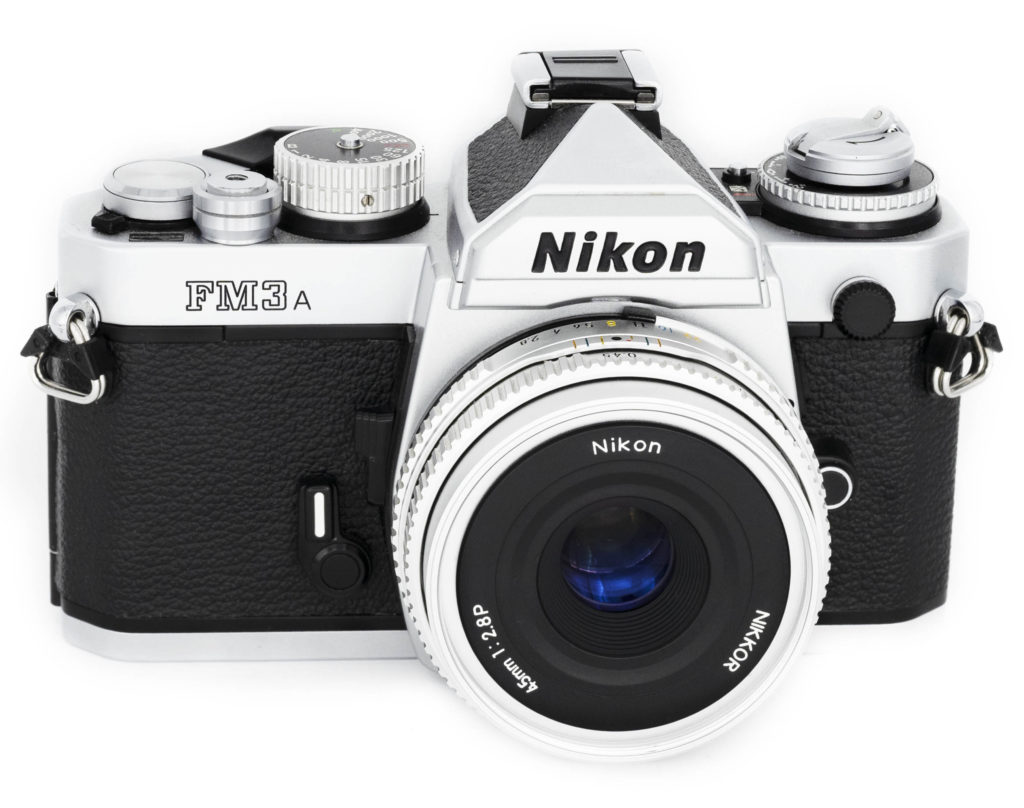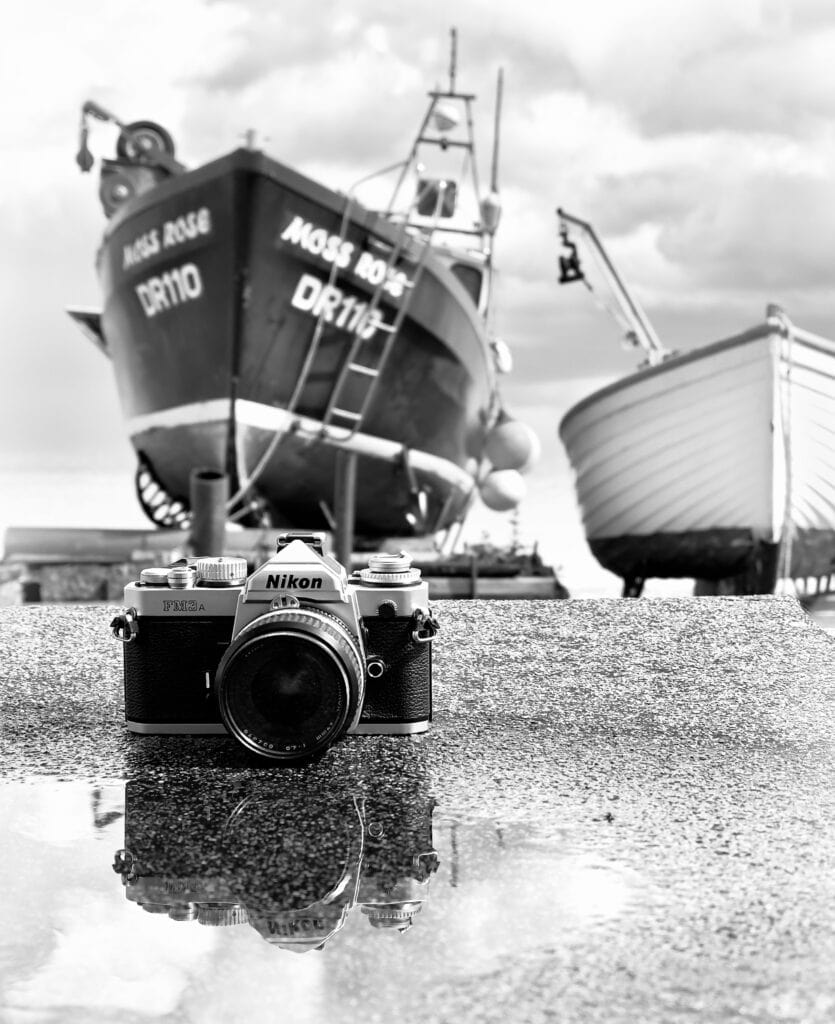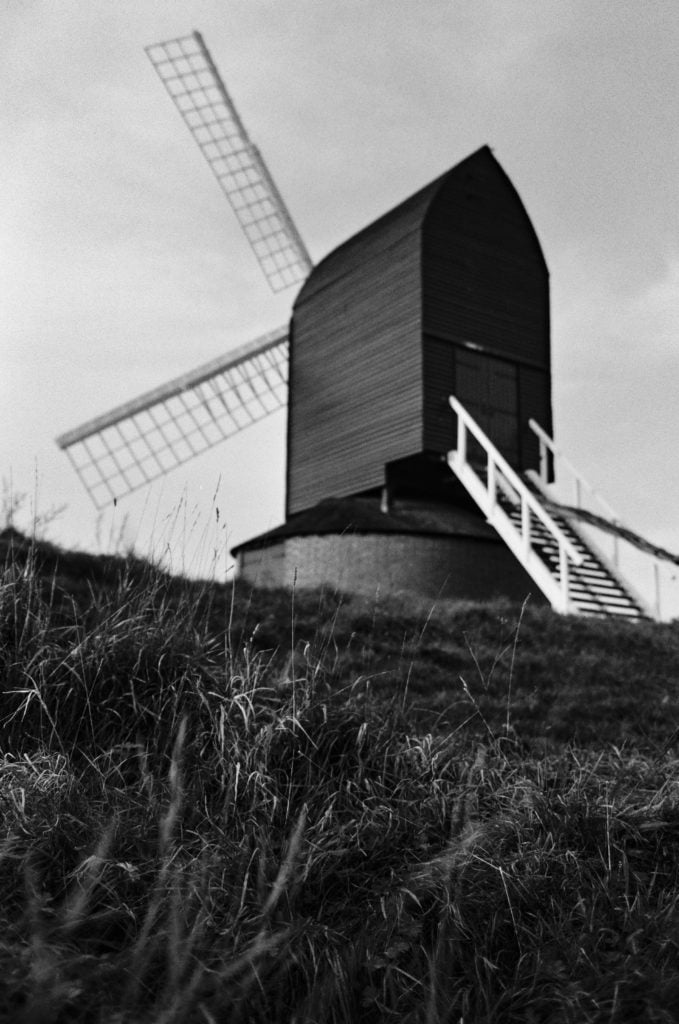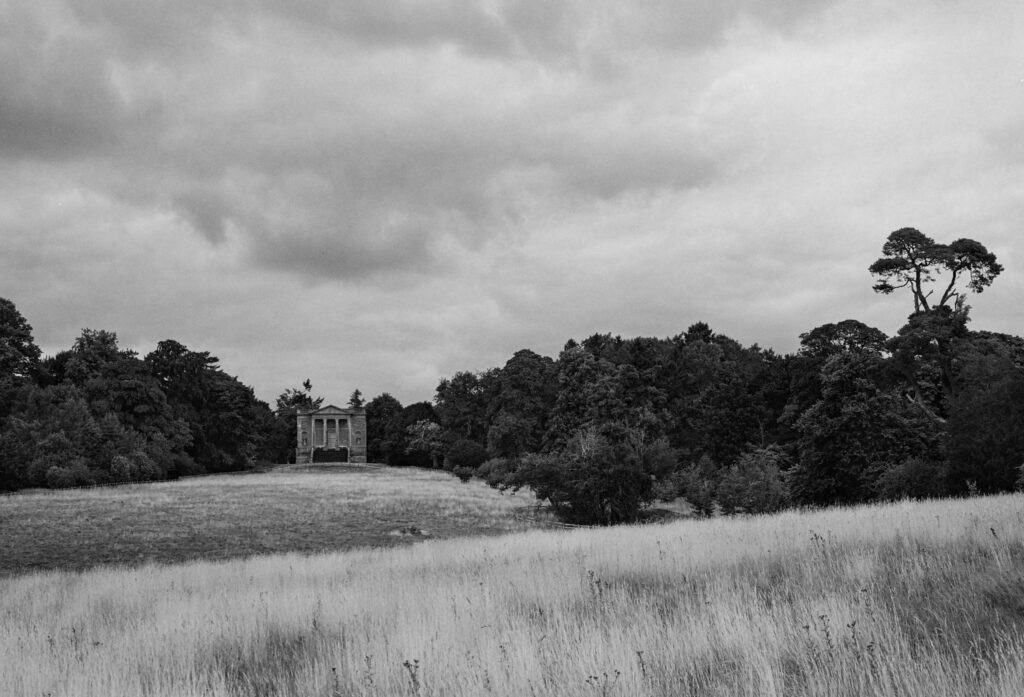The Nikon FM3A (often written as FM3a) is one of the most refined manual SLR’s ever made, and as a 21st century manual focus film SLR, somewhat of a throwback. It was introduced in July 2001 when the shift to digital cameras was well underway. The model was the last of Nikon’s semi-professional line of compact 35 mm film SLRs and one of the brand’s last film cameras; only the autofocus F6 SLR of 2004 and Nikon’s limited edition rangefinder swan song, the SP of 2005, came later.

The D1X, an improved version of Nikon’s first DSLR, the D1, was already out by the time the FM3A was launched. The retro looking FM3A sat on shelves in camera shops around the world next to the hulking digital flagship and autofocus film cameras such as the F5 and F100. Increasing digital camera sales, low sales volume and the increasing costs of such a mechanically sophisticated unit put paid to the FM3A in January 2006. This left only the Nikon F6 and the Cosina manufactured Nikon FM10 in Nikon’s 35mm film SLR line.
Nikon built the FM3A for serious amateur photographers who wanted a a high quality camera with full manual control. Personally, I am grateful for that. It may be a camera out of time, but it is an outstanding piece of engineering: compact, handsome, precise, durable, reliable and a pleasure to shoot with.
Evolution of the F/FE Series
The first model of the mechanical Nikon FM series, the FM was introduced in 1977. Along with the electronic FE of 1978, the FM replaced the mechanical Nikkormat FT series and electronic Nikon EL series.
In 1983 Nikon introduced the mechanical FM2 with a honeycomb-pattern titanium curtain shutter that enabled a top shutter speed of 1/4000 sec and 1/200 sec for flash sync. The flash sync speed increased to 1/250, (identifiable by the flash sync speed labelled in red). This was a huge step forward compared to the FM’s 1/1000 sec. and 1/125 sec. The electronic Nikon FE2 followed later the same year. In 1989 the titanium shutter was replaced by an aluminium version – the FM2n – this is the version I have of the FM2.
The Table below shows the FM and FE series at a glance.
| FM | FE | FM2 | FE-2 | FM-2n | FM3A | |
| Shutter | Mechanical | Electronic | Mechanical | Electronic | Mechanical | Hybrid |
| Automation | None | Aperture | None | Aperture | None | Aperture |
| Max. Shutter Speed (Sec) | 1,000 | 4,000 | ||||
| Flash Sync (Sec) | 1/125 | 1/250 | ||||
| Lens Compatibility Since | 1958 | 1977 | ||||
| Introduced | 1977 | 1978 | 1982 | 1983 | 1984 | 2001 |
| Discontinued | 1982 | 1983 | 1984 | 1987 | 2001 | 2006 |
Development of the Nikon FM3A
Development started in December 1998. Engineers from Mito Nikon (a Nikon production facility that had originally created the Nikkormat of the 1960s and later the F3, FM2n, F4, and others) joined forces with their counterparts at the Ohi Plant. The Ohi facility was the source of Nikon’s first cameras and early models such as the Nikon rangefinders and the Nikon F. Top engineers from these two facilities came together to form a project team.

The FM3A’s predecessor, the manual all-mechanical controlled ‘New FM2‘, had been a best-seller since its introduction in 1984. It was popular amongst experienced amateurs and some professionals, and offered shooting even when the battery was exhausted. At that time Nikon could see also increasing demand for the aperture-priority AE. The project team needed to produce a design that would reconcile these conflicting requirements. Eventually, in order to address the simultaneous availability of aperture-priority AE and battery-free shutter operation, the team decided to adopt a hybrid shutter design.
The hybrid shutter design meant that the shutter had to operate with two control systems. This resulted in a larger, more complicated shutter mechanism with more component parts. As the FM3A was the successor to the New FM2, a larger camera body was not acceptable, meaning the larger shutter unit had to be mounted in the limited space available.
It was extremely difficult to develop a reliable shutter unit with such a complicated mechanism in such a limited space, and in the early stages the project team thought that the highest speed of 1/4000 second would be unattainable. However, after much development work the design was successfully realised. It really was a heroic effort.
Launch and Packaging
The Nikon FM3A was introduced in February 2001 at the PMA show in Orlando, Florida. Prior its introduction, Nikon customers had to choose between the mechanical FM model with manual exposure control or the electronic FE with aperture priority mode that wouldn’t work without batteries.
After the FM3A became available photographers had the best of both worlds with a hybrid shutter that allows both electronically-controlled auto-exposure shooting and full manual control without the need for batteries. The hybrid shutter was an innovation for the FM3A. though the FM3A adopted the traditional exposure meter with indicator needle, which had been continuously applied from the Nikkormat EL released in 1972.
When the FM3A went on sale in July 2001 the shift to digital photography was in full swing. Nikon had released the digital SLR camera D1 in 1999 for professional use and in the same year as the FM3A was released Nikon put the D1X and D1H on the market. Just at the time when digital cameras were going to the mainstream, Nikon consciously chose choice of launch a manual SLR camera. It was a brave move, and one that many photographers applauded then – and now.
The FM3A came in all black and silver and black. For the silver version there was a matching Nikkor 45mm pancake lens available at launch, which is shown in the picture above. The FM3A could make use of a range of accessories such as the Nikon MD-12 motor drive, the MF-16 databack and the various TTL flashes.
The Pancake Lens
In July 2001, the manual focus Nikkor 45 mm f/2.8P AI-s pancake lens went on sale simultaneously with FM3A. It was a lightweight Tessar design just 17 mm deep and weighing only 120 g. The lens consisted of 4 elements in 3 groups with a 7-blade circular diaphragm. Initially the finish was matched to the silver FM3A model, with a black finish added that November. A CPU in the lens enables programmed, aperture-priority, shutter-speed priority, and manual exposure modes. The CPU also enabled it to function with Nikon’s autofocus cameras. It pairs really well with the camera, but my preferred lens is the 50mm f1.4 – which is what I used with the sample shot shown below.
What Makes the Nikon FM3A a Great Camera?

The Nikon FM3A is one of the most refined manual SLR’s ever made. Its compact size, large bright viewfinder, ergonomic controls, excellent analogue light meter display and accurate focusing split image focusing screen make it a pleasure to use. The absence of the normal SLR blackout is an added bonus.
The focusing screen is actually the brightest standard screen of any manual-focus Nikon. This is Type K3 Focusing Screen, the interchangeable focusing screen that comes as standard. The K3 is ‘a matte/Fresnel screen with a split-image rangefinder spot surrounded by a microprism ring and a 12mm centre-weighted area reference circle’. It is optimized for f/2 lenses – faster lenses won’t get any brighter. I’ve found it very easy to use. Nikon introduced two alternatives along with the K3, the E3 matte screen for close ups, and the B3 etched screen with horizontal and vertical lines. The B3’s lines are useful for composition, architectural photography or multiple exposure operation.
The meter is predictable, accurate and extremely easy to use via needle matching. It uses a 60% centre-weighted pattern but also provides a welcome and well-placed AE lock button on the back for manual adjustments. There is also a film window, which was a new feature for the FM series.
The build quality is exceptional. The top and bottom body covers are each drawn from a sheet of brass; the shutter release and film wind cap are lathe-turned, whilst the shutter and film advance actions run on self-lubricating bearings. The film transport mechanism is very tough and makes use of hardened metal gearing.
An Engineering Marvel
Under the covers the Nikon FM3A’s hybrid shutter is one of the most advanced SLR shutters ever built – a marvel of compact mechanical engineering built to such a high standard that it can shoot at 1/4000 of a second without battery power. This is a feat most other mechanical shutters just can’t match, topping out at 1/1000 or 1/2000 of a second. Adding batteries powers the the electronically controlled shutter for aperture priority shooting, the excellent analogue light meter, exposure lock, and DX film coding. Batteries also enable the TTL flash exposure compensation for fill flash – the only manual-focus Nikon to have this feature.
The camera weighs in at 570g, only a little more than the king of compact SLRs – the Olympus OM-1 (510g). At 142.5 x 90 x 58 mm it also compares well against the OM-1’s diminutive 136 x 83 x 50 mm form factor.
I enjoy using the analogue light meter, which is preferable to the one on my F3. The two needles, one matched to your settings and one to the light measured by the meter, are clear and easy to see. That analogue instrument is also far more durable than LEDs. When the inevitable electronics apocalypse claims many of my cameras the FM3a (along with the F and F2) will just keep going…
Drawbacks
Beyond the difficulty of viewfinder visibility in low light, there is very little to say against the FM3A, other than it was, and a remains pricey camera. It has a fixed pentaprism so it isn’t quite as versatile as the F Series cameras with their interchangeable finders, but you can change the focusing screen if you want to. Some also find the locking device on the exposure compensation dial annoying, and it certainly isn’t strictly necessary, but it doesn’t trouble me much.
Comparisons with Other Cameras
The FM3A Vs the FM2n
The FM3A is regularly compared to its predecessor, the FM2n often to determine whether the additional investment for the FM3A is worth it. Both cameras feature an all-mechanical vertically-traveling focal plane shutter capable of taking 1/4000th a second exposures but the FM3A adds electronic aperture priority mode. Both are also very light, but the FM2n comes in a tad lighter at 540g versus 570g. You can shed a few more grams if you go for the FM2/T which makes use of titanium top and bottom plates to get to a very trim 515g for a tough, metal camera.

The most obvious difference to the FM3A is the FM2n’s -o+ LED metering display (a bit like the Leica M6 TTL’s), which is quite different to the FM3A’s analogue twin needle display. The needles are great in normal lighting conditions, whereas the FM2n’s is better in low light. I enjoy shooting with both, but I think the FM3A’s makes for a more engaging shooting experience. The price difference between the two models is even more acute with the black FM3A as it commands a premium as a collector’s item. I went for silver FM3A and a black FM2n, which gives me the best of both worlds.
Nikon FM3A Vs FE2
The FM3A is also regularly compared to the FE2. There a lot of similarities between the FM3A and the FE2, such as the needle matching finder and the 1/4000 maximum shutter speed. These are the differences as far as I can see, not all of which favour the FM3A, depending on your perspective. The FM3A has:
- Fully mechanical operation at all speeds without the need for a battery. FE-2 has 1/250th or B.
- DX film speed encoding
- A different placement for the Auto Exposure (AE) lock button
- A film window to display the film in the camera
- Metering that works immediately after you load the film – no waiting for frame 1
- No rewind knob lock (aka camera back interlock)
- A chrome plated brass lens mount instead of the stainless steel used on the earlier cameras.
Nikon FM3A Vs F3
Curiously, there has been quite a bit of debate on the internet on the FM3A vs the F3, though the current Nikon F pro body at the time of its launch was the F5. A frequently asked question seems to be which one is tougher and more resilient. I have both and they both seem pretty tough, though the F3 seems to have an Achilles heel when using a flash mounted above the rewind knob. There are several reports that if a mounted flash is bumped reasonably hard, the chip which controls exposure functions under the rewind knob can crack, rendering the F3 largely inoperable.
The F3HP has the hot shoe above the prism which fixes that problem, but if you are looking for the toughest possible camera I would take an F2 or original F ‘hockey puck’. I am not sure how useful the comparison is, but the main differences between the F3 and FM3A is that the F3 is heavier and larger, uses LEDs in the viewfinder, offers an interchangeable prism and pro accessories and is slower for flash sync (1/80 versus 1/250) and shutter speed (1/2000 versus 1/4000).
Comparison with Leica M
An odd comparison, for me at least, is one with the Leica M6. In some cases this occurs as part of a search for an SLR that feels as good as a Leica, in others I think it is just a comparison of late model film cameras – the M6 TTL was introduced in 1998, the FM3A in 2001. I shoot with both Nikon and Leica cameras – digital and film, but I am not sure of how useful comparisons are. Rangefinders and SLRs are very different, and Leica takes a unique approach to building cameras and lenses – which is reflected in the cost. I really enjoy shooting with both the M6 TTL (a 0.58 model) and M7 (a 0.85), but I don’t have to worry about finder magnification with the Nikons.
Discontinuation
Unlike the FM2 that was a best-seller for 16 years, the FM3A had a shorter production life. In January 2006, five years from its introduction, production of FM3A was discontinued along with the F100, F80 and other major film cameras. Nikon’s discontinuation was necessary to allow the firm to concentrate its resources on the digital cameras.
Nikon FM3A Specifications
- Shutter: Vertical-travel, metal focal-plane shutter: 8 to 8 to 1/4000 sec step-less aperture-priority auto. Bulb, 1 to 1/4000 sec manual with mechanical control (all settings available without batteries in manual)
- Viewfinder frame Coverage: Approx. 93%
- Viewfinder Magnification: Approx. 0.83x with 50-mm lens set to infinity
- Focusing screen: K3 type (split prism-image microprism type, Clear Matte Screen IIa) standard, B3 type and E3 type optional
- Viewfinder information: Shutter speed, exposure meter indication, shutter indication, direct aperture value, exposure compensation mark, ready light
- Exposure Compensation: ±2 EV in units of 1/3 EV
- Auto Exposure Lock: AE lock button
- Self-timer: Mechanical, countdown time of approx. 4 to 10 seconds
- Flash sync speed: 1/250
- TTL flash Compensation: Compensation to -1 EV activated with the TTL flash compensation button
- Automatic DX film recognition
- Film-check window On rear of camera
- Power Source: One 3-V lithium battery (CR-1/3N type), two 1.55 V silver batteries (SR44 type), or two 1.5 V alkaline batteries (LR44 type)
- Dimensions (W x H x D): Approx. 142.5 x 90 x 58 mm / 5.6 x 3.5 x 2.3 in.
- (camera body only)
- Weight: Approx. 570 g / 20.1 oz. (camera body only, including battery)
Pros and Cons
Pros
- Large, bright viewfinder
- Exceptional build quality, including brass top and bottom plates and a chrome plated brass lens mount.
- Easy manual focus using the split-image focusing patch and micro-prism focusing ring (standard K3 screen)
- Accurate and intuitive needle matching metering
- Fast (1/4000th second) hybrid shutter, which works even without batteries
- Compact and light weight
- Very large choice of lenses, including one designed for the camera (45mm pancake).
- Extremely well featured, including AE lock, TTL flash exposure compensation for fill flash and film recognition window
Cons
- Price – especially in pro black!
- Viewfinder visibility in low light
- Exposure compensation lock?
Conclusion: Future Proof Pleasure
The FM3A is an outstanding piece of engineering that will last long into the future. It is compact, handsome, precise, durable, reliable and a pleasure to shoot with. For me, along with the F, F2 and F6 it is one of Nikon’s greatest cameras. It makes an appearance on a few greatest ever and favourite film cameras lists too, though I think the FM2 shows up just as regularly.
Thoughts and Further Reading
If you have experience with the FM3A please leave me a comment below – I’d love to hear from you, and if you interested in classic cameras you might also enjoy these articles on the site:
- The Nikon F – Nikon’s first SLR
- The Nikon F6 – Nikon’s last film camera
- The Nikon F3 – Back to film
- The Nikon FE
- The Nikon FE2
- The Konica I – Konica’s first rangefinder
- The History of Konica – A history of firsts
- The Kodak No. 2 Autographic Folding Brownie
- From Chemistry to Computation (History of Photography)
- Cameras Year by Year (20th Century Camera timeline)
For more about historically important cameras, visit the year by year timeline.
You’ve been comparing a lot with other electronics and also AF cameras, but how does it compare with the FM2/FM2N cameras?
You didn’t touch on them at all.
Thanks and best regards,
Good point! I didn’t have a point of comparison until recently when I got an FM2n – I’ve updated the blog based on these comments. The most obvious difference is the FM2n’s -o+ LED metering display (a bit like the Leica M6 TTL’s) versus the FM3a’s analogue twin needle display. The needles are great in normal lighting conditions, whereas the FM2N’s is more suited to low light. I like both, but I think the FM3a’s makes for a more engaging shooting experience. The other big difference is that the FM3A offers electronic aperture priority automation while the FM2n is fully manual. I’ve always shot the FM3a in manual as the needle matching is really easy to use, so this doesn’t much matter to me. The FM3a is famous for offering electronic shutter automation whilst the mechanical shutter still works without a battery. As a comparison even the legendary M6 TTL only offers a couple of ’emergency’ mechanical speeds without a battery. With batteries the FM3a’s electronic shutter is also stepless. Again, this really isn’t a big deal to me as I aways carry a spare battery for whatever camera I am shooting with, but some people consider it a big advantage over all other cameras. I like both cameras, but the FM3a has a special place in my heart because I’ve had it for years and the clever hybrid shutter is such an amazing piece of engineering. It’s become quite a collectors piece with prices that reflect that, whilst the FM2n still offers amazing value.
One comparison that shouldn’t be overlooked is the FE/FE2, and even the old Nikkormat EL series. These aperture-priority cameras featured the match-needle display used in the FM3a. Those older cameras were a joy to use, in either auto or manual mode. The FM3a actually replaced both the FM and FE series of cameras, featuring the best of both series. It’s really a shame Nikon didn’t release this camera ten years earlier, before the migration to digital was taking place. I would have gladly bought it as an update to my old FE and F2.
Great point James. I haven’t shot with the FE/FE2 or Nikkormat El but I’ve heard that they were great to shoot with.
I’ve now rectified that and reviewed both the FE and FE2!